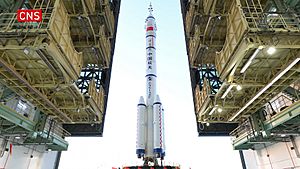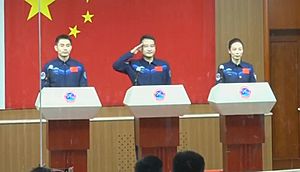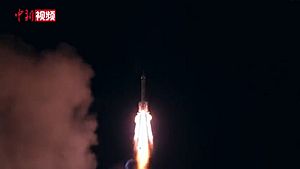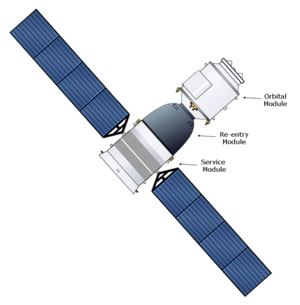Shenzhou 13 facts for kids

Roll out of Shenzhou 13
|
|
| Mission type | Chinese Space Station crew transport |
|---|---|
| Operator | China Manned Space Agency |
| Mission duration | 182 days, 9 hours and 32 minutes |
| Spacecraft properties | |
| Spacecraft | Shenzhou 13 |
| Spacecraft type | Shenzhou |
| Manufacturer | China Aerospace Science and Technology Corporation |
| Crew | |
| Crew size | 3 |
| Members | Zhai Zhigang Wang Yaping Ye Guangfu |
| EVAs | 2 |
| EVA duration | 12 hours 36 minutes |
| Start of mission | |
| Launch date | 15 October 2021, 16:23:56 UTC |
| Rocket | Long March 2F |
| Launch site | Jiuquan, LA-4/SLS |
| Contractor | China Academy of Launch Vehicle Technology |
| End of mission | |
| Landing date | 16 April 2022, 01:56:49 UTC |
| Landing site | Inner Mongolia, China |
| Orbital parameters | |
| Reference system | Geocentric orbit |
| Regime | Low Earth orbit |
| Inclination | 41.5° |
| Docking with Chinese Space Station | |
| Docking port | Tianhe Nadir |
| Docking date | 15 October 2021, 22:56 UTC |
| Undocking date | 15 April 2022, 16:44 UTC |
| Time docked | 181 days, 17 hours and 48 minutes |
 Shenzhou 13 mission patch  Ye Guangfu, Zhai Zhigang and Wang Yaping Shenzhou programme
|
|
Shenzhou 13 (Chinese: 神舟十三号; pinyin: Shénzhōu Shísān-hào; literally "Divine Boat Number 13") was a Chinese space mission. It launched on October 15, 2021. This flight was the eighth time China sent people into space. It was also the thirteenth flight in the Shenzhou program.
The spacecraft carried three Chinese astronauts, also called taikonauts. They traveled to the Tianhe core module, which is the first part of the Tiangong space station. The mission lasted 182 days, setting a new record for China. This was much longer than the 92 days of the previous Shenzhou 12 mission.
Contents
Mission Overview
Shenzhou 13 was an important step for China's space program. It was the first mission planned to last six months (180 days). From now on, six-month stays will be normal for astronauts on the space station. This mission was the second of four crewed flights planned to connect with the Tiangong space station. These missions will help finish building the station by the end of 2022.
Launch and Docking
The Shenzhou 13 spacecraft launched on a Long March-2F rocket. The launch happened from the Jiuquan Satellite Launch Center in China's Gobi Desert. This was on October 15, 2021, at 4:23 PM UTC.
About six and a half hours later, the spacecraft reached the Chinese space station, Tiangong. It connected with the Tianhe core module at 10:56 PM UTC on October 15, 2021. This happened after the Tianzhou 3 cargo ship had already docked there.
The crew entered the Tianhe core module on October 16, 2021. They were the second group of astronauts to live on the Tiangong space station.
Spacewalks
The Shenzhou 13 crew planned to do at least three spacewalks. A spacewalk is when astronauts go outside their spacecraft.
- First Spacewalk: On November 7, 2021, Zhai Zhigang and Wang Yaping did the first spacewalk. They left the Tianhe core module to work outside. Wang Yaping became the first Chinese woman to ever do a spacewalk. They installed parts for a robotic arm and tested equipment. This spacewalk lasted for 6 hours and 25 minutes.
- Second Spacewalk: On December 26, 2021, Ye Guangfu and Zhai Zhigang did the second spacewalk. Wang Yaping helped them from inside the Tianhe module. Ye and Zhai put out an outside camera and installed a foot platform. They also tested ways to move things outside the station. This spacewalk lasted 6 hours and 11 minutes.
Return to Earth
Shenzhou 13 left the Tianhe core module on April 15, 2022. It then quickly started its return to Earth. The part of the spacecraft that carries the crew landed on April 16, 2022. It touched down in Inner Mongolia, China.
The Shenzhou 13 Spacecraft
The Shenzhou 13 spacecraft is very similar to the Russian Soyuz spacecraft. China approved the Shenzhou design in 1992 as part of its space program, called Project 921.
The spacecraft has three main parts:
- Orbital Module: This is at the front. It has a special ring that connects to the Tianhe core module.
- Reentry Module: This is in the middle. It carries the crew and is where they sit during launch and landing.
- Service Module: This is at the back. It holds the engines, fuel tanks, and solar panels that power the spacecraft.
For Shenzhou 13, new technology was used to allow it to connect to the bottom of the Tianhe module. This was different from earlier missions that connected to the front or back. This new way of docking helps create a better system for the space station.
The Crew
The names of the crew members were shared on October 14, 2021.
- Zhai Zhigang was the commander. He had flown in space before on Shenzhou 7.
- Wang Yaping was an operator. She became the first woman to visit the Tiangong Space Station. She had also flown on Shenzhou 10. When Shenzhou 13 finished its mission, Wang had spent about 195 days in space. This set a new record for a Chinese astronaut.
- Ye Guangfu was a system operator. This was his first trip to space.
| Position | Crew member | |
|---|---|---|
| Commander | Second spaceflight |
|
| Operator | Second spaceflight |
|
| System Operator | First spaceflight |
|
Space Lectures from Orbit
The Shenzhou 13 crew gave two special lessons from space. These lessons were broadcast live to students in China. The goal was to teach and inspire young people about science and technology.
First Space Lesson
On December 9, 2021, the three astronauts held their first lesson. The main classroom was at the China Science and Technology Museum in Beijing. Other classrooms were set up in different cities, including Hong Kong and Macau.
Wang Yaping led the science experiments and taught the lesson. The crew showed what their daily life in space was like. They also did experiments on things like how fizzy tablets behave without gravity. Students from the classrooms could ask them questions.
Second Space Lesson
On March 23, 2022, the crew held a second lesson. Again, the main classroom was in Beijing. Other classrooms were in Lhasa and Ürümqi. All three astronauts took turns answering questions from the students after the lesson.
Talking with American Students
On April 10, 2022, the taikonauts had a special question and answer session. They spoke with American students. This event took place at the Chinese Embassy in the U.S. in Washington, D.C.. The Chinese Ambassador to the United States, Qin Gang, hosted the event. Even Elon Musk was part of it, with a video message about future space cooperation.
Images for kids
See also
 In Spanish: Shenzhou 13 para niños
In Spanish: Shenzhou 13 para niños





